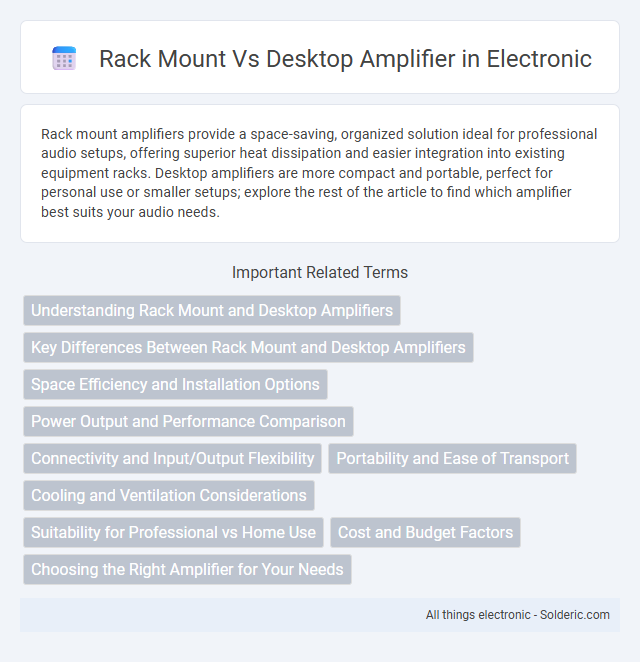Rack mount amplifiers provide a space-saving, organized solution ideal for professional audio setups, offering superior heat dissipation and easier integration into existing equipment racks. Desktop amplifiers are more compact and portable, perfect for personal use or smaller setups; explore the rest of the article to find which amplifier best suits your audio needs.
Comparison Table
| Feature | Rack Mount Amplifier | Desktop Amplifier |
|---|---|---|
| Form Factor | Standardized 19-inch rack width, designed for stacked installation | Compact, placed on desks or flat surfaces |
| Space Efficiency | Optimized for saving space in professional setups | Uses more surface area, less space-efficient |
| Cooling | Built-in cooling fans, suitable for continuous use | Passive or small fans, may overheat in long sessions |
| Power Output | Typically higher wattage for professional applications | Moderate power suitable for personal or small venues |
| Connectivity | Extensive I/O options for integration with pro audio gear | Basic inputs and outputs for simple setups |
| Portability | Less portable, heavier, requires rack infrastructure | Lightweight, easy to move |
| Use Case | Professional studios, live venues, broadcast environments | Home studios, desktop audio, casual listening |
| Price Range | Generally higher due to professional-grade components | Affordable to mid-range |
Understanding Rack Mount and Desktop Amplifiers
Rack mount amplifiers are designed for professional audio systems, featuring a standardized 19-inch chassis that fits into equipment racks, optimizing space and organization in studios and live sound setups. Desktop amplifiers prioritize portability and ease of use with compact, standalone units ideal for small-scale or personal audio applications. Both types deliver powerful audio amplification, but rack mount models offer scalability and integration benefits, while desktop amplifiers emphasize convenience and accessibility.
Key Differences Between Rack Mount and Desktop Amplifiers
Rack mount amplifiers are designed for integration into standardized 19-inch equipment racks, offering space-saving benefits and streamlined cable management in professional audio setups. Desktop amplifiers provide greater portability and ease of access, ideal for smaller or more flexible audio environments where mobility and quick adjustments are crucial. Your choice depends on the scale of your audio system, with rack mount units suited for permanent or large-scale installations, while desktop amplifiers excel in personal or compact setups.
Space Efficiency and Installation Options
Rack mount amplifiers maximize space efficiency by fitting into standardized 19-inch racks, enabling organized stacking and streamlined cable management ideal for professional audio setups. Desktop amplifiers offer flexible installation options for smaller or mobile environments, allowing easy placement on surfaces without requiring specialized rack enclosures. Choosing between rack mount and desktop amplifiers depends on available space and integration needs within audio systems.
Power Output and Performance Comparison
Rack mount amplifiers typically offer higher power output and superior performance due to advanced cooling systems and robust internal components designed for professional audio environments. Desktop amplifiers provide sufficient power for smaller setups but may struggle with sustained high-output demands, making them ideal for personal or compact spaces. Choosing the right amplifier depends on your power needs and performance expectations in your audio setup.
Connectivity and Input/Output Flexibility
Rack mount amplifiers offer superior connectivity with multiple input/output options including XLR, TRS, and RCA connectors, ideal for professional audio setups and easy integration into existing racks. Desktop amplifiers typically feature limited I/O ports, such as basic RCA and headphone jacks, which suit personal or small-scale audio systems but lack extensive flexibility. The rack mount design supports complex signal routing and expanded device compatibility, making it preferable for studios and live sound environments requiring versatile input and output configurations.
Portability and Ease of Transport
Desktop amplifiers offer greater portability for your audio setup due to their compact size and lighter weight, making them easier to carry and place in various locations without requiring specialized racks. Rack mount amplifiers, while more robust and organized for studio or professional environments, typically demand fixed installation within a rack case, which limits ease of transport and increases setup time. Choosing between these options hinges on whether your priority is mobility for on-the-go use or a stable, integrated system for stationary applications.
Cooling and Ventilation Considerations
Rack mount amplifiers are designed with integrated ventilation slots and rear or front-mounted fans to ensure efficient heat dissipation in enclosed rack systems. Desktop amplifiers rely on open-air designs and passive cooling, often featuring heat sinks and natural airflow around the unit. Effective cooling in rack mount units prevents overheating in dense setups, while desktop amplifiers benefit from less confined environments allowing for simpler ventilation solutions.
Suitability for Professional vs Home Use
Rack mount amplifiers are engineered for professional environments, offering scalable power, modular installation in standard 19-inch racks, and enhanced ventilation for heavy-duty use in recording studios, live sound, and broadcast applications. Desktop amplifiers cater to home use with compact designs, user-friendly controls, and lower power output suitable for personal audio setups and small-scale listening environments. The choice hinges on the need for high channel count, durability, and integration in professional settings versus convenience, aesthetics, and moderate amplification at home.
Cost and Budget Factors
Rack mount amplifiers typically offer better value for businesses needing multiple units, as they consolidate equipment and reduce cabling costs, which can lower overall expenses. Desktop amplifiers are generally more affordable upfront, making them suitable for personal use or small setups where budget constraints prioritize initial purchase price over scalability. Your choice depends on whether you prioritize a cost-effective, expandable system or a low-cost, standalone solution.
Choosing the Right Amplifier for Your Needs
Selecting the right amplifier depends on your space, usage, and audio setup requirements. Rack mount amplifiers offer organized, space-saving solutions with easy integration into professional audio systems, making them ideal for studios or live sound environments. Desktop amplifiers suit personal or home use by providing portability, flexible placement, and straightforward access to controls for your everyday audio needs.
rack mount vs desktop amplifier Infographic

 solderic.com
solderic.com